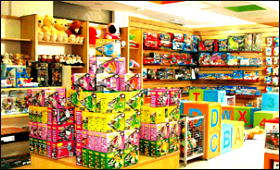|
|
|

|
Non-tariff barriers on toy imports likely early next year
|
|

|
|
| Top Stories |
 |
|
|
|
SME Times News Bureau | 28 Sep, 2020
In line with its ambitious plan to make India a toy hub and self-reliant
in the segment, the Union government is likely to go a step forward and
impose further non-tariff barriers on toy imports.
Official
sources told IANS that the licence regime for toy imports may start in a
phased manner, starting March next year or early FY22. This will be a
follow up of quality control order issued for the industry recently.
The
first priority for the government in its bid to make India
"Aatmanirbhar" or self reliant in the toy sector, however, is to make
the domestic industry achieve high quality standards, people in the know
said.
So, although further non-tariff barriers are on the anvil,
the Centre does not want to rush in before the quality control order of
the government comes into effect in January and the industry is well in
compliance with the norms. Earlier this month, the timeline was
extended for the domestic toy manufacturers to comply with the new
standards till January 1.
In a recent meeting, Union Commerce
Minister Piyush Goyal took stock of developments on this front along
with the required action plan for the future, sources said.
The
ministry has identified toys among several categories of non-essential
imports, where restrictions could be considered. In recent months, the
Commerce Ministry has resorted to the use of import restrictions instead
of free imports to boost domestic manufacturing.
In December,
the government raised the import duty on toys by 200 per cent to 60 per
cent from earlier 20 per cent. This, however, had limited impact on
putting a check on unrestricted imports. India has been importing toys
of an average value of about $285 million for last three years. But
total imports in the category including electronic parts, is to the tune
of over $650 million.
Noting that the global toy industry is
worth over Rs 7 lakh crore but that India's share is very small in the
sector, Prime Minister Narendra Modi, in his monthly radio broadcast
'Mann Ki Baat' last month gave a clarion call to be "vocal for local
toys", stressing on the need for making the country a toy hub.
The
Prime Minister said that the toy industry is very diverse and some of
the regions in India are being developed as toy clusters to make the
nation a toy hub.
This is a fresh push for the industry after
Modi in one of his addresses to the nation during the nationwide
lockdown stressed on 'Aatmanirbhar Bharat' or a self reliant India and
asked Indians to be 'vocal for local' products.
Industry players,
although hailing the view of boosting the domestic toy industry, are of
the view that curbing imports would severely impact the market as the
domestic players only supply around 15 per cent of the total demand in
the country.
They have time and again called for government support to augment production capacity.
The
government, however, plans to expand the scope of the production-linked
incentive (PLI) to toys along with other sectors to garner investments
in the segment, which if successful will boost the manufacturing
capacity in the country.
The global toy industry size is
estimated at $100 billion and India has a market size of $1.75 billion
in 2019, including both formal and informal sectors. India reported a
15.9 per cent growth rate from 2011 to 2018.
Among other issues
facing the sector, the manufacturers lack technical expertise and
capability for manufacturing electronic toys, although there is
availability of raw material for local manufacturing.
|
|
|
| |
|
|
|
|
|
|
|
|
|
|
|
|
|
|
| |
| Customs Exchange Rates |
| Currency |
Import |
Export |
US Dollar
|
84.35
|
82.60 |
UK Pound
|
106.35
|
102.90 |
Euro
|
92.50
|
89.35 |
| Japanese
Yen |
55.05 |
53.40 |
| As on 12 Oct, 2024 |
|
|
| Daily Poll |
 |
 |
| Do you think Indian businesses will be negatively affected by Trump's America First Policy? |
|
|
|
|
|
| Commented Stories |
 |
|
|
|
|
|
| |
|